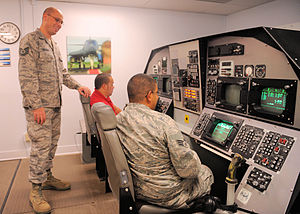436th Training Squadron
 | |
|---|---|
 A 436th Training Squadron instructor trains two individuals on the weapons flightline course at Dyess AFB | |
| Active | 1917–1927; 1928–1946; 1946–1963; 1986–present |
| Country | |
| Branch | |
| Role | Training |
| Size | Squadron |
| Part of | Air Combat Command |
| Garrison/HQ | Dyess Air Force Base, Texas |
| Engagements | World War I Occupation of the Rhineland Southwest Pacific Theater China Burma India Theater |
| Decorations | Distinguished Unit Citation Air Force Meritorious Unit Award Air Force Outstanding Unit Award |
| Commanders | |
| Notable commanders | Hugh J. Knerr Lewis H. Brereton[1] |
| Insignia | |
| 436th Training Squadron emblem[a] |  |
| 88th Observation Squadron emblem[b][2] |  |
The 436th Training Squadron is a non-flying training squadron of the United States Air Force. The 436th Training Squadron, located at Dyess Air Force Base, Texas, is a geographically separated unit within Air Combat Command’s 552nd Air Control Wing, at Tinker Air Force Base, Oklahoma.
The 436th is one of the oldest units in the United States Air Force, first being organized as the 88th Aero Squadron on 18 August 1917 at Kelly Field, Texas. The squadron deployed to France and fought on the Western Front during World War I as a Corps observation squadron.
The squadron returned to the United States in 1919. In 1921, it participated in tests off the Atlantic coast of Virginia designed to test the effectiveness of aircraft against battleships. Following the tests the squadron moved to Ohio, where it served as the aviation element of the 5th Division until 1927, when it moved to Texas as a training unit, but was inactivated shortly after the move and its personnel and equipment used to form another squadron. It was reactivated in 1928, becoming a long range reconnaissance unit in 1935. In 1941, it was ordered to reinforce the air defenses of the Philippines.
On 7 December 1941, elements of the 88th Reconnaissance Squadron were one of the Boeing B-17 Flying Fortress units that landed at Hickam Field, Hawaii during the Japanese attack on Pearl Harbor. Until March 1942, it engaged in combat missions in the Pacific. It moved to the China Burma India Theater, entering combat in June as the 436th Bombardment Squadron . It converted from the B-17 to the Consolidated B-24 Liberator in the combat zone in fall 1942. From June through October 1944, the squadron was removed from combat operations and was engaged in airlifting fuel to bases in China to support Boeing B-29 Superfortress strikes. It returned to combat and earned the Distinguished Unit Citation for an attack on railroads in Thailand. Following V-J Day, the squadron returned to the United States for inactivation.
The squadron was reactivated in 1946 as part of Strategic Air Command's (SAC) strike force. In 1948, it began flying Convair B-36 Peacemakers It converted to Boeing B-52 Stratofortresses and dispersed To Barksdale Air Force Base. It maintained half of its bombers on alert during the Cold War, and placed all planes on alert during the Cuban Missile Crisis. The 436th inactivated in 1963 in a general reorganization of SAC units.
The squadron was reactivated in its current role as the 436th Strategic Training Squadron in 1986
Cite error: There are <ref group=lower-alpha> tags or {{efn}} templates on this page, but the references will not show without a {{reflist|group=lower-alpha}} template or {{notelist}} template (see the help page).